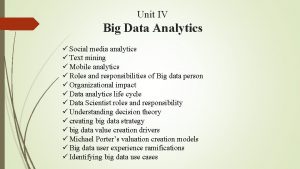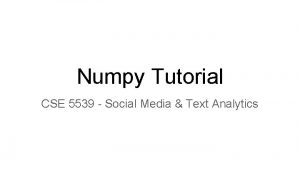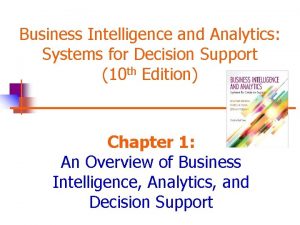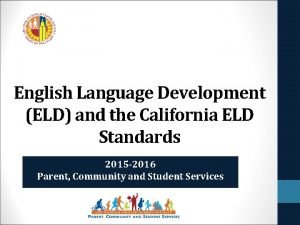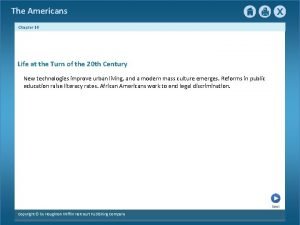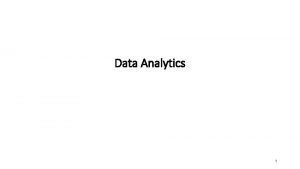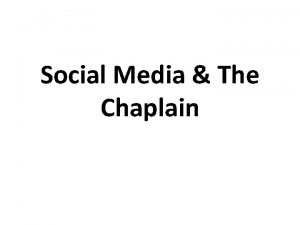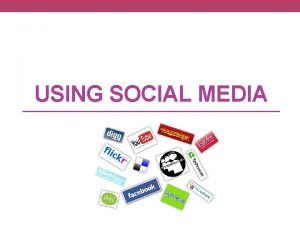Expanding Social Media Literacies Through Social Media Analytics























- Slides: 23

Expanding Social Media Literacies Through Social Media Analytics NATHA N J. C ARPENTER, P H. D. NJCARP E @ILSTU. EDU SCHOOL OF C OMMUNICATIO N

Assumptions about Social Media “Social media platforms are mostly for entertainment and have become a negative distraction. ” ◦ approximately 60% of Americans get their news via social media platforms ◦ 69% of adults in U. S. use social media; 34% of adults in U. S. age 65 + “Young people are experts in social media because they are already immersed in it. ” ◦ Familiarity does not equate with competence ◦ Personal networks are very different from public networks “We don’t teach public relations, marketing, or journalism, so we don’t need to address social media in our fields. ” ◦ opportunities to engage with the public, have conversations in the discipline, network with other professionals

Overview Part One: Framework for Social Media Literacy Part Two: Core Concepts in Social Media Analytics Part Three: Examples of Analytics in the Classroom

Part One FRAMEWORK FOR SOCIAL MEDIA LITERACY

Framework for Social Media Literacy What are the competencies required for participation? Vanwynsberghe, Hadewijch; and Verdegem, Pieter (2013). "Integrating Social Media in Education. " CLCWeb: Comparative Literature and Culture 15. 3

Practical Competencies Having access to computers / smartphones Knowing how to open a web browser and log into an account Ability to open and read content Writing and deploying computer code

Cognitive Competencies What-knowledge ◦ Basic knowledge needed to access media technologies, content, or services ◦ Knowing what settings are relevant and how to change them ◦ Knowing the conventions of a platform (hashtags, mentions, reactions, etc. ) How- / why-knowledge ◦ ◦ Analytical knowledge and critical thinking Who is the producer of a message and why are they communicating? How do social media create different public spaces? How do we understand the political, cultural, social and historical contexts of social media content?

Affective Competencies Acknowledging attitudes ◦ How does one perceive interactivity? ◦ How does one perceive exchanging information? ◦ How does one perceive other users? Understanding One’s Motivation ◦ How can one enhance one’s skills or gain a positive reaction from others? ◦ Does one believe one has the necessary skills to perform online activities?

Framework for Social Media Literacy Deal with uses and consequences of social media use Vanwynsberghe, Hadewijch; and Verdegem, Pieter (2013). "Integrating Social Media in Education. " CLCWeb: Comparative Literature and Culture 15. 3

Uses of Social Media 1. Search for or deal with information on social media 2. Communicate with others 3. Create content 4. Deal with critical consequences of the above activities

Part Two SOCIAL MEDIA ANALYTICS


Social Media Analytics Process 1. Collecting data 2. Understanding themes and patterns 3. Presenting findings

Social Media Analytics Purposes 1. Describing current trends and patterns 2. Prescribing courses of action 3. Predicting future outcomes Techniques: ◦ ◦ ◦ Text mining Content analysis Metadata analysis Social network analysis Cartographic mapping

Part Three ANALYTICS IN THE CLASSROOM

Personal Twitter Analytics http: //analytics. twitter. com

Personal Twitter Analytics Competencies Practical ◦ Finding and running analytics in Twitter ◦ Exporting content Cognitive ◦ ◦ Differences between metrics Ability to compare trends over time Ability to assess and make recommendations Critical assessment of why Twitter provides analytics Affective ◦ Build confidence in tweeting ◦ Recognize apprehensions or biases about the platform

Facebook Page Comparison https: //apps. facebook. com/netvizz/

Facebook Page Comparison Competencies Practical ◦ Exporting data from Facebook ◦ Using Microsoft Excel to make charts and graphs Cognitive ◦ ◦ Selecting relevant points of comparison Identify trends over time Identify differences in organizational goals and strategies Recognize privacy issues and potential surveillance Affective ◦ Build confidence in working with raw data ◦ Recognize effective posting strategies

Social Network Analysis

Social Network Analysis Competencies Practical ◦ How to collect data ◦ How to graph relationships among users Cognitive ◦ Assessing how we measure influence ◦ Examining how social media leverage power structures ◦ Recognizing how social media platforms might contribute to polarization Affective ◦ “Wow” factor that energizes students, participants ◦ Builds confidence in using mathematical theory and application

Get Started with Netlytic https: //netlytic. org

Consult with the SMACC
 Teramond
Teramond Big data and social media analytics
Big data and social media analytics Watson social media data analytics
Watson social media data analytics Social media analytics tutorial
Social media analytics tutorial Social media analytics and text mining
Social media analytics and text mining Business intelligence and analytics 10th edition
Business intelligence and analytics 10th edition Through one man sin entered the world, and through one man
Through one man sin entered the world, and through one man Classes of furcation
Classes of furcation Tangent-sawing
Tangent-sawing I watched the flame feeding on my mother
I watched the flame feeding on my mother Blackboard uws
Blackboard uws Sample of people in media
Sample of people in media Expanding the pie negotiation example
Expanding the pie negotiation example Identify a warning sign of a weak talent bench
Identify a warning sign of a weak talent bench Image search
Image search How do you expand double brackets
How do you expand double brackets Emerging expanding bridging levels
Emerging expanding bridging levels Expanding double brackets worksheet
Expanding double brackets worksheet Expanding double brackets
Expanding double brackets Defining paragraph examples
Defining paragraph examples Pool germany
Pool germany Chapter 9 expanding markets and moving west
Chapter 9 expanding markets and moving west Objectives of matrices
Objectives of matrices Chapter 16 section 1 science and urban life
Chapter 16 section 1 science and urban life

